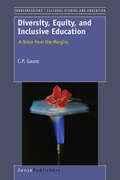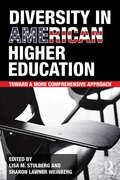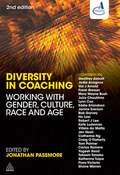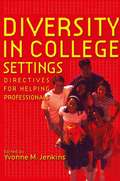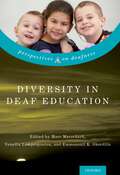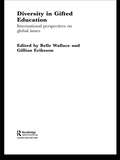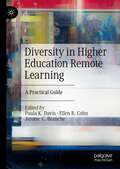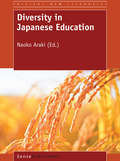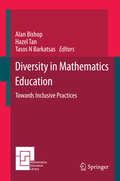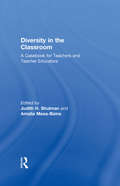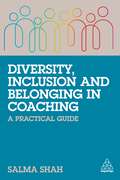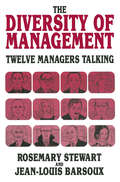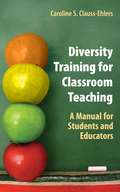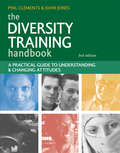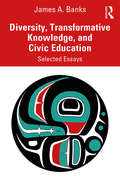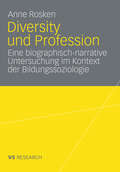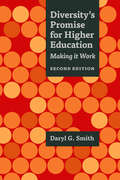- Table View
- List View
Diversity, Equity, and Inclusive Education: A Voice From The Margins (Transgressions #65)
by C.P. GauseThe United States is more ideologically, philosophically, culturally, linguistically, racially, and ethnically diverse than she has been in any given point in her history; however, many of her citizens are currently living in a state of fear. What stands out the most is how we allow this fear to take over our lives in multiple ways. We fear our neighbors; therefore, we do not engage them. We fear young people and the way they look; therefore, we do not have conversations with them. We fear the possibility of terrorists’ attacks; therefore, we utilize eavesdropping and surveillance devices on our citizens. There are some of us who fear the lost of gun rights; therefore, we stockpile weapons. We fear anything that is different from who we are and what we believe. This nation has, at many points within our history, become more united because of our fear; however, as our borders, physical and virtual, become less protective and the opportunities to connect more via the digital world expand, we must educate our citizenry to not live in fear but in hope. To teach, learn, and lead democratically requires the individual to engage in problem posing and in critiquing taken-for-granted narratives of power and privilege. Critical change occurs with significant self-sacrifice, potential alienation/rejection, and costly consequences. Educators must do justice to the larger social, public, and institutional responsibility of our positions, and we must exercise courage in creating opportunities for change. Diversity, Equity, and Inclusive Education: A Voice from the Margins, provides the space and opportunity to move beyond a state of fear, into a state of “organic transformation,” a place where fear creates the energy to speak those things that are not, as though they were.
Diversity in American Higher Education: Toward a More Comprehensive Approach
by Lisa M. Stulberg Sharon Lawner WeinbergDiversity has been a focus of higher education policy, law, and scholarship for decades, continually expanding to include not only race, ethnicity and gender, but also socioeconomic status, sexual and political orientation, and more. However, existing collections still tend to focus on a narrow definition of diversity in education, or in relation to singular topics like access to higher education, financial aid, and affirmative action. By contrast, Diversity in American Higher Education captures in one volume the wide range of critical issues that comprise the current discourse on diversity on the college campus in its broadest sense. This edited collection explores: legal perspectives on diversity and affirmative action higher education's relationship to the deeper roots of K-12 equity and access policy, politics, and practice's effects on students, faculty, and staff. Bringing together the leading experts on diversity in higher education scholarship, Diversity in American Higher Education redefines the agenda for diversity as we know it today.
Diversity in American Higher Education: Toward a More Comprehensive Approach
by Lisa M. Stulberg Sharon Lawner WeinbergDiversity has been a focus of higher education policy, law, and scholarship for decades, continually expanding to include not only race, ethnicity and gender, but also socioeconomic status, sexual and political orientation, and more. However, existing collections still tend to focus on a narrow definition of diversity in education, or in relation to singular topics like access to higher education, financial aid, and affirmative action. By contrast, Diversity in American Higher Education captures in one volume the wide range of critical issues that comprise the current discourse on diversity on the college campus in its broadest sense. This edited collection explores: legal perspectives on diversity and affirmative action higher education's relationship to the deeper roots of K-12 equity and access policy, politics, and practice's effects on students, faculty, and staff. Bringing together the leading experts on diversity in higher education scholarship, Diversity in American Higher Education redefines the agenda for diversity as we know it today.
Diversity in Coaching: Working with Gender, Culture, Race and Age
by Jonathan PassmorePublished with the Association for Coaching, Diversity in Coaching explores the impact and implication of difference in coaching. The book looks at how coaches can respond to issues of gender, generational, cultural, national and racial difference. Understanding how diversity impacts upon coaching is a crucial element to coaching effectively in today's diverse society and can give coaches the edge when responding to their coachees need.Written by an international team of coaching professionals, the book provides guidance on understanding diversity and how coaches can adapt coaching styles and techniques to meet individual needs, local demands and cultural preferences.It explores the impact and implication of difference in coaching, providing practical information to help coaches respond effectively to issues of diversity.
Diversity in Coaching: Working with Gender, Culture, Race and Age
by Jonathan PassmorePublished with the Association for Coaching, Diversity in Coaching explores the impact and implication of difference in coaching. The book looks at how coaches can respond to issues of gender, generational, cultural, national and racial difference. Understanding how diversity impacts upon coaching is a crucial element to coaching effectively in today's diverse society and can give coaches the edge when responding to their coachees need.Written by an international team of coaching professionals, the book provides guidance on understanding diversity and how coaches can adapt coaching styles and techniques to meet individual needs, local demands and cultural preferences.It explores the impact and implication of difference in coaching, providing practical information to help coaches respond effectively to issues of diversity.
Diversity in College Settings: Directives for Helping Professionals
by Yvonne M. JenkinsFirst Published in 1999. Routledge is an imprint of Taylor & Francis, an informa company.
Diversity in College Settings: Directives for Helping Professionals
by Yvonne M. JenkinsFirst Published in 1999. Routledge is an imprint of Taylor & Francis, an informa company.
Diversity in Deaf Education (Perspectives on Deafness)
by Marc Marschark and Venetta Lampropoulou Emmanouil K. SkordilisDeaf children are not hearing children who can't hear. Beyond any specific effects of hearing loss, as a group they are far more diverse than hearing peers. Lack of full access to language, incidental learning, and social interactions as well as the possibility of secondary disabilities means that deaf learners face a variety of challenges in academic domains. Technological innovations such as digital hearing aids and cochlear implants have improved hearing and the possibility of spoken language for many deaf learners, but parents, teachers, and other professionals are just now coming to recognize that there are cognitive, experiential, and social-emotional differences between deaf and hearing students likely to affect academic outcomes. Sign languages and schools and programs for deaf learners thus remain an important part of the continuum of services needed for this diverse population. Understanding such diversity and determining ways in which to accommodate them must become a top priority in educating deaf learners. Through the participation of an international, interdisciplinary set of scholars, Diversity in Deaf Education takes a broad view of learning and academic progress, considering "the whole child" in the context of the families, languages, educational settings in which they are immersed. In adopting this perspective, the complexities and commonalities in the social, emotional, cognitive, and linguistic mosaic of which the deaf child is a part, are captured. It is only through such a holistic consideration of diverse children developing within diverse settings that we can understand their academic potentials.
Diversity in Deaf Education (Perspectives on Deafness)
Deaf children are not hearing children who can't hear. Beyond any specific effects of hearing loss, as a group they are far more diverse than hearing peers. Lack of full access to language, incidental learning, and social interactions as well as the possibility of secondary disabilities means that deaf learners face a variety of challenges in academic domains. Technological innovations such as digital hearing aids and cochlear implants have improved hearing and the possibility of spoken language for many deaf learners, but parents, teachers, and other professionals are just now coming to recognize that there are cognitive, experiential, and social-emotional differences between deaf and hearing students likely to affect academic outcomes. Sign languages and schools and programs for deaf learners thus remain an important part of the continuum of services needed for this diverse population. Understanding such diversity and determining ways in which to accommodate them must become a top priority in educating deaf learners. Through the participation of an international, interdisciplinary set of scholars, Diversity in Deaf Education takes a broad view of learning and academic progress, considering "the whole child" in the context of the families, languages, educational settings in which they are immersed. In adopting this perspective, the complexities and commonalities in the social, emotional, cognitive, and linguistic mosaic of which the deaf child is a part, are captured. It is only through such a holistic consideration of diverse children developing within diverse settings that we can understand their academic potentials.
Diversity in Gifted Education: International Perspectives on Global Issues
by Gillian Eriksson Belle WallaceThis timely book brings together experts from around the world to share expertise and best practice to form an eclectic collection of the best approaches for teaching gifted and talented children from different cultures. Each chapter: presents an overview of international perspectives on the issues of multi-cultural and gifted education examines the critical issues related to cultural definitions of giftedness in programming for diverse gifted students presents regional case studies in order to inform practitioners' best practice examines issues of access for gifted students in relation to culture, poverty, race and gender. In addition, details of websites and associations which offer support and advice are also provided, making this book an invaluable resource for academics, researchers, teachers and parents of gifted and talented children.
Diversity in Gifted Education: International Perspectives on Global Issues
by Belle Wallace Gillian ErikssonThis timely book brings together experts from around the world to share expertise and best practice to form an eclectic collection of the best approaches for teaching gifted and talented children from different cultures. Each chapter: presents an overview of international perspectives on the issues of multi-cultural and gifted education examines the critical issues related to cultural definitions of giftedness in programming for diverse gifted students presents regional case studies in order to inform practitioners' best practice examines issues of access for gifted students in relation to culture, poverty, race and gender. In addition, details of websites and associations which offer support and advice are also provided, making this book an invaluable resource for academics, researchers, teachers and parents of gifted and talented children.
Diversity in Higher Education Remote Learning: A Practical Guide
by Paula K. Davis Ellen R. Cohn Jerome C. BrancheThis book provides fundamental principles of remote instruction and classroom management for diversity. Chapters explore the requisite characteristics of higher education administration and infrastructure that support both online and hybrid learning. It draws on proven practices to help research intensive faculty, instructional and clinical faculty, and adjunct faculty deliver efficient and effective online class construction for today's classrooms.
Diversity in Japanese Education (Critical New Literacies: The Praxis of English Language Teaching and Learning (PELT))
by Naoko ArakiNo one is born fully-formed: it is through self-experience in the world that we become what we are. – Paulo Freire Diversity in Japanese Education explores ‘self-experience’ of individual learners and educators in Japan. The word ‘diversity’ is not limited to one’s ethnic background. Here, diversity refers to one’s pedagogical experiences and life experiences; to the norms, beliefs and values that impact such relations. These experiences and relations are fluid as they are shaped and reshaped in global and glocal settings. They are also reflected in praxis of English language learning and teaching in Japan. The authors’ educational backgrounds vary but they all share the common ground of being educators in Japan. Through being involved in learning and/or teaching English language in Japan, they have witnessed and experienced ‘diversity’ in their own pedagogical context. The book focuses on shifting critical and reflexive eyes on qualitative studies of pedagogical experiences rather than presenting one ‘fixed’ view of Japanese education.
Diversity in Mathematics Education: Towards Inclusive Practices (Mathematics Education Library #113)
by Alan Bishop Hazel Tan Tasos N BarkatsasThis book presents a research focus on diversity and inclusivity in mathematics education. The challenge of diversity, largely in terms of student profiles or contextual features, is endemic in mathematics education, and is often argued to require differentiation as a response. Typically different curricula, text materials, task structures or pedagogies are favoured responses, but huge differences in achievement still result. If we in mathematics education seek to challenge that status quo, more research must be focussed not just on diversity but also on the inclusivity, of practices in mathematics education. The book is written by a group of experienced collaborating researchers who share this focus. It is written for researchers, research students, teachers and in-service professionals, who recognise both the challenges but also the opportunities of creating and evaluating new inclusive approaches to curriculum and pedagogy – ones that take for granted the positive values of diversity. Several chapters report new research in this direction. The authors are part of, or have visited with, the mathematics education staff of the Faculty of Education at Monash University, in Melbourne, Australia. The chapters all focus on the ideas of development in both research and practice, recognising that the current need is for new inclusive approaches. The studies presented are set in different contexts, including Australia, China, the United States, and Singapore.
Diversity in the Classroom: A Casebook for Teachers and Teacher Educators
by Judith H. Shulman Amalia Mesa-BainsThis casebook is part of a nationwide effort to capture and use practitioner knowledge to better prepare teachers for the reality of today's classrooms, given a student population vastly different from that of even a decade ago. Consciously designed to provoke engaging and demanding discussion, the cases presented here are candid, dramatic, highly readable accounts of teaching events or series of events. Set in three of the nation's most diverse cities -- San Francisco, Los Angeles, and Phoenix -- the cases offer problem-based snapshots of on-the-job dilemmas. The teacher-authors discuss topics that generate heated interchange and run the risk of polarizing opinions and creating defensive assumptions, particularly those dealing with bias, race, and class. These issues, plus cultural behaviors and socioeconomic circumstances have important implications for classroom practices. By examining such issues, the editors hope that educators will see -- and act on -- the need for a greater variety of teaching styles, distribution of opportunities, and educational access for all students.
Diversity in the Classroom: A Casebook for Teachers and Teacher Educators
by Judith H. Shulman Amalia Mesa-BainsThis casebook is part of a nationwide effort to capture and use practitioner knowledge to better prepare teachers for the reality of today's classrooms, given a student population vastly different from that of even a decade ago. Consciously designed to provoke engaging and demanding discussion, the cases presented here are candid, dramatic, highly readable accounts of teaching events or series of events. Set in three of the nation's most diverse cities -- San Francisco, Los Angeles, and Phoenix -- the cases offer problem-based snapshots of on-the-job dilemmas. The teacher-authors discuss topics that generate heated interchange and run the risk of polarizing opinions and creating defensive assumptions, particularly those dealing with bias, race, and class. These issues, plus cultural behaviors and socioeconomic circumstances have important implications for classroom practices. By examining such issues, the editors hope that educators will see -- and act on -- the need for a greater variety of teaching styles, distribution of opportunities, and educational access for all students.
Diversity, Inclusion and Belonging in Coaching: A Practical Guide
by Salma ShahCoaching and developing employees is not a one size fits all activity. Race, gender, class, education, culture and religion can all affect the needs of employees. Coaches, leaders and line managers must address this.Diversity, Inclusion and Belonging in Coaching is a practical guide for coaches, leaders and line managers which explains how to understand different employee needs, identify what experiences can impact these needs and shows how to develop a truly inclusive approach to coaching and employee development. It also covers how to recognize the difference between employees in survival mode as opposed to those who are thriving, feeling psychologically safe and displaying healthy resilience. Packed full of practical tips, tools, case studies, interviews, examples and activities to work through in practice, this book allows coaches, leaders and line managers to create an inclusive culture of belonging and psychological safety to ensure that all employees flourish. There is also specific guidance on how to deal with employee trauma such as prejudice, racism, bullying, burnout, imposter syndrome and grief as well as how to cultivate a system of acceptance and encourage all employees to safely bring their authentic selves to work. Supported by expert advice, personal experience and industry research, this book is crucial reading for all coaches, leaders and managers responsible for talent development.
The Diversity of Management: Twelve Managers Talking
by Jean-Louis Barsoux Rosemary StewartTwelve lively accounts are given, based on searching interviews, of very different kinds of managerial jobs. They paint a picture of what the job is like, the work that the individual does, and how he or she feels about it. The jobs are compared and lessons are drawn for career guidance, selection and management development as well as how far managerial skills are transferable. The accounts can also be used as case studies and questions are provided for students.
Diversity Training for Classroom Teaching: A Manual for Students and Educators
by Caroline S. Clauss-EhlersAcknowledgements Section 1. Foundations 3 Chapter 1. Introduction: How to Use this Manual.. ................... Chapter 2. How Do We Understand Difference?. ...................... 17 Section 2. Dimensions of Difference: Culture, Socioeconomic Status, Race, Ethnicity, Language, and Parental Partnership 29 Chapter 3. Cultural Values and Worldview.. ............................ Chapter 4. Socioeconomic Status.. ....................................... 4 1 ............................................ 5 1 Chapter 5. Race and Ethnicity.. Chapter 6. Language in the Classroom.. .................................. 67 Chapter 7. Working with Diverse Families: Parental Partnership in Education.. ........................................ 8 1 viii Table of Contents Section 3 . Dimensions of Difference: Gender Chapter 8 . Gender ............................................................ Chapter 9 . Sexual Orientation and Youth ................................. Section 4 . Other Challenges to Diversity Chapter 10 . Bullying in Schools ............................................. Chapter 1 1 . Creating Community through Classroom Management .. Chapter 12 . Child Abuse and Resilience .................................. Section 5 . Understanding Exceptional Microcultures Chapter 13 . Exceptional Microcultures: Dealing with Trauma ...... Chapter 14 . Exceptional Microcultures: Youth with Emotional Disturbance- Childhood Depression. Eating Disorders .................. Chapter 15 . Exceptional Microcultures: How to Make a Referral .. Section 6 . Conclusion Chapter 16 . Conclusion: The Multicultural Educator .................. Selected Bibliography ...................................................... Glossary of Terms ........................................................... Appendix A . Sample Course Syllabus .................................... Appendix B . Educational Intervention Proposal Paper ................. Index ............................................................................ Diversity Training for Classroom Teaching: A Manual for Students and Educators is an excellent guide for preparing responsive teachers, capable of exploring the roots of a wide variety of types of diversity and acting with knowledge and sensitivity to improve student learning and self-efficacy.
The Diversity Training Handbook: A Practical Guide to Understanding and Changing Attitudes
by John Jones Phil ClementsDiversity issues and the need to understand and, if necessary, change underlying attitudes has become increasingly important for organizations. The Diversity Training Handbook provides a practical approach to dealing with this sensitive and vital issue. From one of the authors of the highly successful Equal Opportunities Handbook, this 3rd edition is updated to include new chapters on facilitating diversity training and the management of black and minority ethnic staff, as well as information on the Equality and Human Rights Commission.The Diversity Training Handbook provides clear guidelines for dealing with issues including stereotyping, prejudice, racism, sexism, ageism and disability and contains information and advice on appropriate techniques to help bring about attitudinal change.
Diversity, Transformative Knowledge, and Civic Education: Selected Essays
by James A. BanksThe essays collected in this book, by James A. Banks, a foundational figure in the field of multicultural education, illuminate the interconnection between the author’s work on knowledge construction and civic education. In pieces both poignant and personal, Banks shares some of his most groundbreaking and innovative work. Diversity, Transformative Knowledge, and Civic Education aims to unpack the "citizenship-education dilemma," whereby education programs strive to teach students democratic ideals and values within social, economic, political, and educational contexts that contradict justice, equality, and human rights. For change to take place, students need to internalize democratic values, by directly experiencing them in transformative classrooms and schools that are envisioned and described in this book. Drawn from Banks’ formidable canon, this collection highlights the conceptual, curricular, and pedagogical issues related to this dilemma, and signals a fundamental shift toward transformative citizenship education. Students, scholars and educators in the fields of multicultural education, civic education, social studies education, comparative education, and the foundations of education will find this book to be a valuable resource for discussion and discovery.
Diversity, Transformative Knowledge, and Civic Education: Selected Essays
by James A. BanksThe essays collected in this book, by James A. Banks, a foundational figure in the field of multicultural education, illuminate the interconnection between the author’s work on knowledge construction and civic education. In pieces both poignant and personal, Banks shares some of his most groundbreaking and innovative work. Diversity, Transformative Knowledge, and Civic Education aims to unpack the "citizenship-education dilemma," whereby education programs strive to teach students democratic ideals and values within social, economic, political, and educational contexts that contradict justice, equality, and human rights. For change to take place, students need to internalize democratic values, by directly experiencing them in transformative classrooms and schools that are envisioned and described in this book. Drawn from Banks’ formidable canon, this collection highlights the conceptual, curricular, and pedagogical issues related to this dilemma, and signals a fundamental shift toward transformative citizenship education. Students, scholars and educators in the fields of multicultural education, civic education, social studies education, comparative education, and the foundations of education will find this book to be a valuable resource for discussion and discovery.
Diversity und Profession: Eine biographisch narrative Untersuchung im Kontext der Bildungssoziologie
by Anne RoskenIm Zentrum der vorgelegten Dissertation von Frau Rosken steht das Phänomen Diversity und die Frage, welche Arten des professionellen Umgangs Erzieherinnen mit diesem Phänomen entwickeln. Eine entsprechende Untersuchung ist im Bereich Elementarer Bildung bislang unbekannt, die Arbeit von Frau Rosken hat damit Pilotfunktion. Dabei ist Diversity ein Begriff, der in den letzten Jahren als Ausdruck für - ziale Vielfalt, unterschiedliche Milieus und Ethnien, für divergierende Interessen und Bedürfnisse von Individuen und Gruppierungen in die Diskussion gekommen ist. Allzu oft gerät er in den Strudel gut meinender Sichtweisen. Was dann bleibt, ist buntes Vielerlei und harmonisches Miteinander – zumindest als normatives K- strukt. Gegen solche Formen des Weichzeichnens von Phänomenen der Diversity setzt Anne Rosken mit der vorliegenden Arbeit einen eindeutigen Kontrapunkt. So forscht sie nach Diversity-Kompetenzen bei Erzieherinnen, d. h. nach Fähigkeiten, professionell mit Unterschieden und Ungleichheit, Fremdheit und Auffälligkeiten bei den Kindern umzugehen. Die Autorin richtet ihren Blick insbesondere auf das Wissen, auf subjektive pädagogische Konzepte, auf Haltungen sowie auf Fähigk- ten und Kompetenzen im pädagogischen Handeln im Kontext von Diversity. Sie vermutet, dass weniger pädagogisch-professionelle Konzepte und die berufliche Aus- und Fortbildung die Ausprägung dieser spezifischen Kompetenzen beeinfl- sen, da es entsprechende Konzepte, wenn überhaupt, ja auch nur in Ansätzen gibt.
Diversity's Promise for Higher Education: Making It Work
by Daryl G. SmithDaryl G. Smith has devoted her career to studying and fostering diversity in higher education. She has witnessed and encouraged the evolution of diversity from an issue addressed sporadically on college campuses to a reality of the modern university experience. In Diversity’s Promise for Higher Education, Smith brings together scholarly and field research relevant to the next generation of diversity work. The book argues that achieving excellence in a diverse society requires increasing the institutional capacity for diversity while simultaneously working to understand how diversity is tied to better leadership, positive change, research in virtually every field, student success, accountability, and more equitable hiring practices. To become more relevant to society, the nation, and the world while remaining true to their core missions, colleges and universities must continue to see diversityâ€�like technologyâ€�as central, not parallel, to their work. In Diversity’s Promise for Higher Education, Smith proposes a set of clear and realistic practices that will help colleges and universities locate diversity as a strategic imperative and pursue diversity efforts that are inclusive of the variedâ€�and growingâ€�issues apparent on campuses without losing focus on the critical unfinished business of the past.In this edition, which is aimed at administrators, faculty, researchers, and students of higher education, Smith emphasizes a transdisciplinary approach to the topic of diversity, drawing on an updated list of sources from a wealth of literatures and fields. The tables have been refreshed to include data on faculty diversity over a twenty-year period and the book includes new information about gender identity, stereotype threat, student success, the growing role of chief diversity officers, the international emergence of diversity issues, faculty hiring, and implicit bias.
Diversity's Promise for Higher Education: Making It Work
by Daryl G. SmithDaryl G. Smith has devoted her career to studying and fostering diversity in higher education. She has witnessed and encouraged the evolution of diversity from an issue addressed sporadically on college campuses to a reality of the modern university experience. In Diversity’s Promise for Higher Education, Smith brings together scholarly and field research relevant to the next generation of diversity work. The book argues that achieving excellence in a diverse society requires increasing the institutional capacity for diversity while simultaneously working to understand how diversity is tied to better leadership, positive change, research in virtually every field, student success, accountability, and more equitable hiring practices. To become more relevant to society, the nation, and the world while remaining true to their core missions, colleges and universities must continue to see diversityâ€�like technologyâ€�as central, not parallel, to their work. In Diversity’s Promise for Higher Education, Smith proposes a set of clear and realistic practices that will help colleges and universities locate diversity as a strategic imperative and pursue diversity efforts that are inclusive of the variedâ€�and growingâ€�issues apparent on campuses without losing focus on the critical unfinished business of the past.In this edition, which is aimed at administrators, faculty, researchers, and students of higher education, Smith emphasizes a transdisciplinary approach to the topic of diversity, drawing on an updated list of sources from a wealth of literatures and fields. The tables have been refreshed to include data on faculty diversity over a twenty-year period and the book includes new information about gender identity, stereotype threat, student success, the growing role of chief diversity officers, the international emergence of diversity issues, faculty hiring, and implicit bias.
